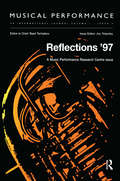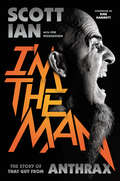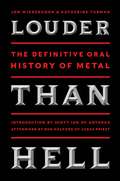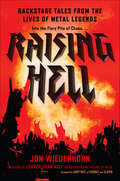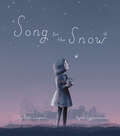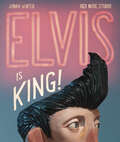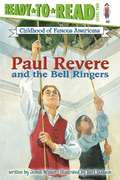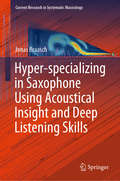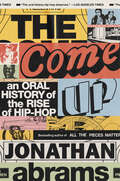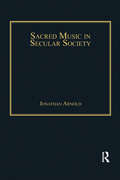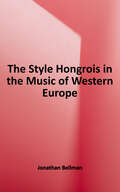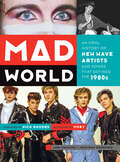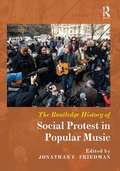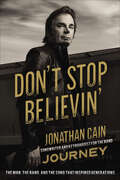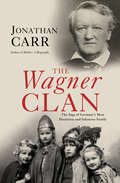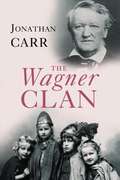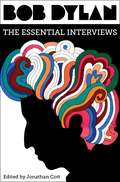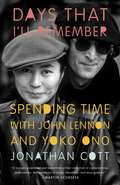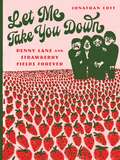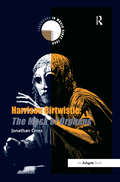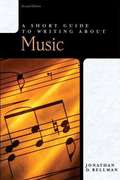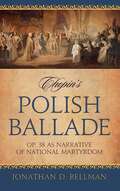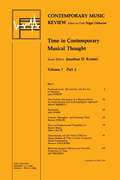- Table View
- List View
Reflections '97: A special issue of the journal Musical Performance
by Jon TolanskyReflections, the Yearbook of the Music Performance Research Centre, is published as an issue within the international journal Musical Performance series. It features articles written by musicians and interviews with performers. Reflections '97 includes an interview with the tenor Jon Vickers and a personal memoir of the conductor Carlos Kleiber.
I'm the Man: The Story of That Guy from Anthrax
by Jon Wiederhorn Scott IanThe long-awaited and vastly entertaining autobiography of Scott Ian, guitarist and founder of groundbreaking and influential thrash metal legend Anthrax
Louder Than Hell: The Definitive Oral History of Metal
by Jon Wiederhorn Katherine TurmanThe definitive oral history of heavy metal, Louder Than Hell by renowned music journalists Jon Wiederhorn and Katherine Turman includes hundreds of interviews with the giants of the movement, conducted over the past 25 years. Unlike many forms of popular music, metalheads tend to embrace their favorite bands and follow them over decades. Metal is not only a pastime for the true aficionados; it’s a lifestyle and obsession that permeates every aspect of their being. Louder Than Hell is an examination of that cultural phenomenon and the much-maligned genre of music that has stood the test of time. Louder than Hell features more than 250 interviews with some of the biggest bands in metal, including Black Sabbath, Metallica, Megadeth, Anthrax, Slayer, Iron Maiden, Judas Priest, Spinal Tap, Pantera, White Zombie, Slipknot, and Twisted Sister; insights from industry insiders, family members, friends, scenesters, groupies, and journalists.
Raising Hell: Backstage Tales from the Lives of Metal Legends
by Jon WiederhornFrom the author of the celebrated classic Louder Than Hell comes an oral history of the badass Heavy Metal lifestyle—the debauchery, demolition, and headbanging dedication—featuring metalhead musicians from Black Sabbath and Judas Priest to Twisted Sister and Quiet Riot to Disturbed, Megadeth, Throwdown and more. In his song “You Can’t Kill Rock and Roll” Ozzy Osbourne sings, “Rock and roll is my religion and my law.” This is the mantra of the metal legends who populate Raising Hell—artists from Black Sabbath, Judas Priest, Slipknot, Slayer, and Lamb of God to Twisted Sister, Quiet Riot, Disturbed, Megadeth, and many more! It’s also the guiding principle for underground voices like Misery Index, Gorgoroth, Municipal Waste, and Throwdown. Through the decades, the metal scene has been populated by colorful individuals who have thwarted convention and lived by their own rules. For many, vice has been virtue, and the opportunity to record albums and tour has been an invitation to push boundaries and blow the lid off a Pandora’s box of riotous experiences: thievery, vandalism, hedonism, the occult, stage mishaps, mosh pit atrocities, and general insanity. To the figures in this book, metal is a means of banding together to stick a big middle finger to a society that had already decided they didn’t belong. Whether they were oddballs who didn’t fit in or angry kids from troubled backgrounds, metal gave them a sense of identity. Drawing from 150-plus first-hand interviews with vocalists, guitarists, bassists, keyboardists, and drummers, music journalist Jon Wiederhorn offers this collection of wild shenanigans from metal’s heaviest and most iconic acts—the parties, the tours, the mosh pits, the rage, the joy, the sex, the drugs . . . the heavy metal life! Horns up!
Song for the Snow
by Jon-Erik LappanoCan a long-forgotten song bring the snow back to Freya’s town? A lyrical fable from award-winning creators Jon-Erik Lappano and Byron Eggenschwiler. Freya has always loved the snow and the way it covers everything like powdered sugar. But the snow hasn’t come to her town for two winters, and she’s starting to forget what it looks and feels like. When will it be cold? When will it snow again? One day Freya finds a snow globe at the market. It plays the melody of a song that the townspeople sang for generations to call the snow home. Freya’s own grandmother used to sing it to her mother on cold winter nights. Every morning, Freya takes the snow globe outside and sings the song, but still there is no snow … until she has the idea to share the song. Soon everyone in town is singing it, and then, early one morning, the winds change. Jon-Erik Lappano and Byron Eggenschwiler have created an eloquent fable about remembering past traditions, our connection to nature and caring for a world threatened by climate change through shared effort and hope. Correlates to the Common Core State Standards in English Language Arts: CCSS.ELA-LITERACY.RL.K.1 With prompting and support, ask and answer questions about key details in a text. CCSS.ELA-LITERACY.RL.1.2 Retell stories, including key details, and demonstrate understanding of their central message or lesson. CCSS.ELA-LITERACY.RL.1.4 Identify words and phrases in stories or poems that suggest feelings or appeal to the senses. CCSS.ELA-LITERACY.RL.1.7 Use illustrations and details in a story to describe its characters, setting, or events.
Elvis Is King!
by Jonah WinterElvis Presley--the King of Rock 'n' Roll, still beloved by millions of Americans--comes to vibrant, gyrating life in this extraordinary picture-book biography from an award-winning author and the winner of a New York Times Best Illustrated Book Award.Here's the perfect book for anyone who wants to introduce rock 'n' roll and its king to the child in their lives. In single- page "chapters" with titles like "The First Cheeseburger Ever Eaten by Elvis" and "Shazam! A Blond Boy Turns into a Black-Haired Teenager," readers can follow key moments in Presley's life, from his birth on the wrong side of the railroad tracks in the Deep South, to playing his first guitar in grade school, to being so nervous during a performance as a teenager that he starts shaking . . . and changes the world!Jonah Winter and Red Nose Studio have created a tour-de-force that captures a boy's loneliness and longing, along with the energy and excitement, passion, and raw talent that was Elvis Presley."Readers will want to pore over this thoroughly engaging volume." -- Kirkus Reviews, starred review
Paul Revere and the Bell Ringers (Ready-to-read Level 2)
by Jonah WinterYoung Paul Revere and his friends form a club whose members ring the bells at Christ Church, an experience which teaches him responsibility and other lessons that he uses as an adult in the American Revolution.
Hyper-specializing in Saxophone Using Acoustical Insight and Deep Listening Skills (Current Research in Systematic Musicology #6)
by Jonas BraaschThis book presents a novel method of grafting musical wind instruments by exchanging an instrument’s standard mouthpiece with different tone generators. Using the concrete example of the soprano saxophone, it describes how, with six other tone generators, including brass, double reed, and free reed mechanisms, the saxophone can be extended to nearly every wind instrument category in the von Hornbostel and Sachs classification system. The book demonstrates how it is possible to play these instrument variations with high proficiency, and describes the method of hyper-specialization, including acoustical insights, conservatory training methods and the underlying philosophy. The latter is based on the cultural traditions of the different wind instrument prototypes and the Deep Listening philosophy of cultivating internal diversity, and approach that leads to a new level of wind instrument virtuosity that offers great timbral variety combined with the flexibility of a regular acoustic wind instrument.
Grandfather's Gamelan (Fountas & Pinnell Classroom, Guided Reading Grade 4)
by Maribel Lechuga Jonas WestoverNIMAC-sourced textbook
The Come Up: An Oral History of the Rise of Hip-Hop
by Jonathan AbramsThe essential oral history of hip-hop, from its origins on the playgrounds of the Bronx to its reign as the most powerful force in pop culture—from the award-winning journalist behind All the Pieces Matter, the New York Times bestselling oral history of The Wire &“The Come Up is Abrams at his sharpest, at his most observant, at his most insightful.&”—Shea Serrano, #1 New York Times bestselling author of Hip-Hop (And Other Things) The music that would come to be known as hip-hop was born at a party in the Bronx in the summer of 1973. Now, fifty years later, it&’s the most popular music genre in America. Just as jazz did in the first half of the twentieth century, hip-hop and its groundbreaking DJs and artists—nearly all of them people of color from some of America&’s most overlooked communities—pushed the boundaries of music to new frontiers, while transfixing the country&’s youth and reshaping fashion, art, and even language.And yet, the stories of many hip-hop pioneers and their individual contributions in the pre-Internet days of mixtapes and word of mouth are rarely heard—and some are at risk of being lost forever. Now, in The Come Up, the New York Times bestselling author Jonathan Abrams offers the most comprehensive account so far of hip-hop&’s rise, a multi-decade chronicle told in the voices of the people who made it happen. In more than three hundred interviews conducted over three years, Abrams has captured the stories of the DJs, executives, producers, and artists who both witnessed and themselves forged the history of hip-hop. Masterfully combining these voices into a seamless symphonic narrative, Abrams traces how the genre grew out of the resourcefulness of a neglected population in the South Bronx, and from there how it flowed into New York City&’s other boroughs, and beyond—from electrifying live gatherings, then on to radio and vinyl, below to the Mason-Dixon Line, west to Los Angeles through gangster rap and G-funk, and then across generations. Abrams has on record Grandmaster Caz detailing hip-hop&’s infancy, Edward &“Duke Bootee&” Fletcher describing the origins of &“The Message,&” DMC narrating his role in introducing hip-hop to the mainstream, Ice Cube recounting N.W.A&’s breakthrough and breakup, Kool Moe Dee recalling his Grammys boycott, and countless more key players. Throughout, Abrams conveys with singular vividness the drive, the stakes, and the relentless creativity that ignited one of the greatest revolutions in modern music. The Come Up is an exhilarating behind-the-scenes account of how hip-hop came to rule the world—and an essential contribution to music history.
Sacred Music in Secular Society
by Jonathan ArnoldIf music has ever given you 'a glimpse of something beyond the horizons of our materialism or our contemporary values' (James MacMillan), then you will find this book essential reading. Sacred Music in Secular Society is a new and challenging work asking why Christian sacred music is now appealing afresh to a wide and varied audience, both religious and secular. Jonathan Arnold offers unique insights as a professional singer of sacred music in liturgical and concert settings worldwide, as an ordained Anglican priest and as a senior research fellow. Blending scholarship, theological reflection and interviews with some of the greatest musicians and spiritual leaders of our day, including James MacMillan and Rowan Williams, Arnold suggests that the intrinsically theological and spiritual nature of sacred music remains an immense attraction particularly in secular society. Intended by the composer and inspired by religious intentions this theological and spiritual heart reflects our inherent need to express our humanity and search for the mystical or the transcendent. Offering a unique examination of the relationship between sacred music and secular society, this book will appeal to readers interested in contemporary spirituality, Christianity, music, worship, faith and society, whether believers or not, including theologians, musicians and sociologists.
The Style Hongrois in the Music of Western Europe
by Jonathan BellmanA study of the development of the style hongrois (Hungarian style), a specific musical language used by Western composers from the mid-18th through the 19th centuries (including Weber, Schubert, Liszt, and Brahms) to evoke the performances of Hungarian Gypsies.
Mad World: An Oral History of New Wave Artists and Songs That Defined the 1980s
by Jonathan Bernstein Lori MajewskiA &“hugely entertaining&” history of the 1980s New Wave music scene told through new interviews with its biggest artists (Rolling Stone). Mad World is a compelling oral history that celebrates the New Wave music phenomenon of the 1980s via new interviews with 35 of the most notable artists of the period. Each chapter begins with a discussion of their most popular song and leads to stories of their history and place in the scene, ultimately painting a vivid picture of this colorful, idiosyncratic time. Mixtape suggestions, fashion sidebars, and quotes from famous contemporary admirers help fill out the fun. Participants include members of Duran Duran, New Order, The Smiths, Tears for Fears, Adam Ant, Echo, and the Bunnymen, Devo, ABC, Spandau Ballet, A Flock of Seagulls, Thompson Twins, INXS, and more. &“One addictive chapter after another.&” —Rob Sheffield, author of Talking to Girls About Duran Duran &“Tells the tale of some of the decade&’s most unforgettable songs . . . in fascinating detail, letting the architects of these memorable records shine a light on how the sound of a generation came to be.&” —The Hollywood Reporter &“The new wave era is often dismissed for its one-hit wonders and silly haircuts, but [Mad World] examines the period with a great deal of love and reverence.&” —Buzzfeed &“A really informative and insightful read.&” —People
The Routledge History of Social Protest in Popular Music
by Jonathan C. FriedmanThe major objective of this collection of 28 essays is to analyze the trends, musical formats, and rhetorical devices used in popular music to illuminate the human condition. By comparing and contrasting musical offerings in a number of countries and in different contexts from the 19th century until today, The Routledge History of Social Protest in Popular Music aims to be a probing introduction to the history of social protest music, ideal for popular music studies and history and sociology of music courses.
Don't Stop Believin': The Man, the Band, and the Song that Inspired Generations (5 Finger Ser.)
by Jonathan CainKeyboardist and songwriter with the band Journey, Jonathan Cain writes this long-awaited memoir about his personal story of overcoming and faith, his career with one of the most successful musical groups in history, and the stories behind his greatest hits including "Don't Stop Believin'."When Jonathan Cain and the iconic band Journey were inducted into the Rock and Roll Hall of Fame, Cain could say he had finally arrived. But Cain's journey wasn't always easy--and his true arrival in life had more to do with faith than fame.As a child, Cain survived a horrific school fire that killed nearly 100 of his classmates. His experience formed a resilience that would carry him through both tragedy and success. Moving from Chicago to Sunset Boulevard, Cain never let go of his dreams, eventually getting his big break with Journey--and writing the songs that would become the soundtrack of a generation.Don't Stop Believin' is an epic story of one man's dream that takes you from playing old-country songs at an Italian Deli in Chicago and his experiences with a warm, encouraging father who died too soon, to suddenly writing mega-bestselling songs with some of the most talented musicians and performers ever to take the stage of some of the world's largest arenas. He tells of the thrilling moments when the music came together and offers an inside look at why Steve Perry left and the extraordinary story of their gifted new vocalist, Arnel Pineda.Through a wonderful retrospective of music that takes us right to the present, Jonathan Cain reminds us of the melodies and lyrics that serve as milestones for our biggest dreams as they call us to never stop believing.
The Wagner Clan: The Saga of Germany's Most Illustrious and Infamous Family
by Jonathan CarrAn Economist Best Book of 2007, Jonathan Carr’s The Wagner Clan proves, with the sweeping scope of a Wagnerian opera, that the history of Europe and that of the infamous composer’s family are inextricably intertwined. Carr presents not only Richard Wagner himself- musician, philosopher, philanderer, failed revolutionary, and virulent anti-Semite-but also a colorful cast of historical figures who feature in Wagner’s story: Franz Liszt (whose illegitimate daughter Cosima married Wagner); Friedrich Nietzsche; Arthur Schopenhauer; Richard Strauss; Gustav Mahler; Arturo Toscanini; Joseph Goebbels; Hermann Göring; and the "Wolf ” himself, Adolf Hitler, a passionate fan of the Master’s music and an adopted uncle to Wagner’s grandchildren. Wagner’s British-born daughter-in-law, Winifred, was a close friend of Hitler’s and seemed momentarily positioned to marry him after the death of her husband. All through the war the Bayreuth Festival, begun by the Master himself, was supported by Hitler, who had to fill the audience with fighting men and SS officers. After the war’s devastation, the festival was dark for a decade until Wagner’s offspring-with characteristic ambition and cunning- revived it. The Wagner Clan is a riveting chronicle of the ascent, decline, and rehabilitation of the German nation and its most infamous family.
The Wagner Clan: The Saga of Germany's Most Illustrious and Infamous Family
by Jonathan CarrollA well-researched account of the composer Richard Wagner's later life and the lives of his contentious descendants down to the present.
Bob Dylan: The Essential Interviews
by Jonathan Cott“A historical compilation to savor” (Los Angeles Times) that is “invaluable…irresistible” (The New York Times)—the ultimate collection of interviews and encounters with Nobel Laureate Bob Dylan, spanning his entire career from 1962 to today.Bob Dylan: The Essential Interviews features over two dozen of the most significant and revealing conversations with the singer, gathered in one definitive collection that spans his career from street poet to Nobel Laureate. First published in 2006, this acclaimed collection brought together the best interviews and encounters with Bob Dylan to create a multi-faceted, cultural, and journalistic portrait of the artist and his legacy. This edition includes three additional pieces from Rolling Stone that update the volume to the present day. Among the highlights are the seminal Rolling Stone interviews—anthologized here for the first time—by Jann Wenner, Jonathan Cott, Kurt Loder, Mikal Gilmore, Douglas Brinkley, and Jonathan Lethem—as well as Nat Hentoff’s legendary 1966 Playboy interview. Surprises include Studs Terkel’s radio interview in 1963 on WFMT in Chicago, the interview Dylan gave to screenwriter Jay Cocks when he was a student at Kenyon College in 1964, a 1965 interview with director Nora Ephron, and an interview Sam Shepard turned into a one-act play for Esquire in 1987. Introduced by Rolling Stone editor Jonathan Cott, these intimate conversations from America’s most celebrated street poet is a “priceless collection with honest, open, and thoughtful musings…a fascinating window into his one-of-a-kind mind” (Publishers Weekly).
Days That I'll Remember: Spending Time with John Lennon and Yoko Ono
by Jonathan CottJonathan Cott met John Lennon in 1968 and was friends with him and Yoko Ono until John's death in 1980. He has kept in touch with Yoko since that time, and is one of the small group of writers who understands her profoundly positive influence on Lennon. This deeply personal book recounts the course of those friendships over the decades and provides an intimate look at two of the most astonishing cultural figures of our time. And what Jonathan Cott has to say and tell will be found nowhere else.
Let Me Take You Down: Penny Lane and Strawberry Fields Forever
by Jonathan CottThe conception, creation, recording, and significance of the Beatles&’ &“Penny Lane&” and &“Strawberry Fields Forever&” John Lennon wrote &“Strawberry Fields Forever&” in Almería, Spain, in fall 1966, and in November, in response to that song, Paul McCartney wrote &“Penny Lane&” at his home in London. A culmination of what was one of the most life-altering and chaotic years in the Beatles&’ career, these two songs composed the 1967 double A-side 45 rpm record that has often been called the greatest single in the history of popular music and was, according to Beatles producer George Martin, &“the best record we ever made.&” In Let Me Take You Down: Penny Lane and Strawberry Fields Forever, Jonathan Cott recounts the conception and creation of these songs; describes the tumultuous events and experiences that led the Beatles to call it quits as a touring band and redefine themselves solely as recording artists; and details the complex, seventy-hour recording process that produced seven minutes of indelible music. In writing about these songs, he also focuses on them as inspired artistic expressions of two unique ways of experiencing and being in the world, as Lennon takes us down to Strawberry Fields and McCartney takes us back to Penny Lane. In order to gain new vistas and multiple perspectives on these multifaceted songs, Cott also engages in conversation with five remarkable people: media artist Laurie Anderson; guitarist Bill Frisell; actor Richard Gere; Jungian analyst Margaret Klenck; and urban planner, writer, and musician Jonathan F. P. Rose. The result is a wide-ranging, illuminating exploration of the musical, literary, psychological, cultural, and spiritual aspects of two of the most acclaimed songs in rock and roll history.
Harrison Birtwistle: The Mask Of Orpheus (Landmarks In Music Since 1950 Ser.)
by Jonathan CrossHailed at its premiere at the London Coliseum in 1986 as the most important musical and theatrical event of the decade, The Mask of Orpheus is undoubtedly a key work in Harrison Birtwistle's output. His subsequent stage and concert pieces demand to be evaluated in its light. Increasingly, it is also viewed as a key work in the development of opera since the Second World War, a work that pushed at the boundaries of what was possible in lyrical theatre. In its imaginative fusion of music, song, drama, myth, mime and electronics, it has become a beacon for many younger composers, and the object of wide critical attention. Jonathan Cross begins his detailed study of this 'lyric tragedy' by placing it in the wider context of the reception of the Orpheus myth. In particular, the significance of Orpheus for the twentieth century is discussed, and this provides the backdrop for an examination of Birtwistle's preoccupation with the story in a variety of works across his creative life. The sources and genesis of The Mask of Orpheus are explored. This is followed by a close reading of the work's three acts, analysing their structure and meaning, investigating the relationship between music, text and drama, drawing on Zinovieff's textual drafts and Birtwistle's compositional sketches. The book concludes by suggesting a range of contexts within which The Mask of Orpheus might be understood. Its central themes of time, memory and identity, loss, mourning and melancholy, touch a deep sensibility in late-modern society and culture. Interviews with the librettist and composer round off this important study.
The Cambridge Companion to Stravinsky
by Jonathan CrossContains a wide range of essays reflecting the breadth of Stravinsky's musical achievement.
A Short Guide to Writing about Music
by Jonathan D. BellmanWritten in a clear and conversational style, A Short Guide to Writing About Music examines a wide range of writing assignments for music courses at all levels of the undergraduate curriculum. Employing a variety of writing samples as a means to illustrate effective writing, this brief and inexpensive text teaches writers how to deftly research and write about music.
Chopin's Polish Ballade: Op. 38 As Narrative of National Martyrdom
by Jonathan D. BellmanChopin's Second Ballade, Op. 38 is frequently performed and takes only seven or so minutes to play. Yet the work remains very poorly understood - disagreement prevails on issues from its tonic and two-key structure to its posited relationship with the poems of Adam Mickiewicz. Chopin's PolishBallade is a reexamination and close analysis of this famous work, revealing the Ballade as a piece with a powerful political story to tell. Through the general musical styles and specific references in the Ballade, which use both operatic strategies and approaches developed in programmatic piano pieces for amateurs, author Jonathan Bellman traces a clear narrative thread to contemporary French operas. His careful historical exegesis of previously ignored musical and cultural contexts brings to light a host of new insights about this remarkable piece, which, as Bellman shows, reflects the cultural preoccupations of the Polish emigres in mid-1830s Paris, pining with bitter nostalgia for a homeland now under Russian domination. This vital connection to the extramusical culture of its day forms the basis for a plausible relationship with the nationalistic poetry of Mickiewicz. Chopin's Polish Ballade also solves the long-standing conundrum of the two extant versions of the Ballade, making an important point about the flexible notion of "work" that Chopin embraced.
Time in Contemporary Musical Thought (Contemporary Music Review #Vols. 7, Pts. 2)
by Jonathan D. KramerFirst Published in 1993. Routledge is an imprint of Taylor & Francis, an informa company.
